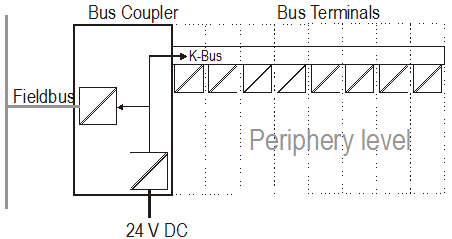Power supply, potential groups
Power supply
The Bus Couplers require a 24 V DC supply for their operation. In the case of the BK52x0 Bus Couplers this is connected via the upper spring-loaded terminals marked "24 V" and "0 V". This supply voltage feeds not only the Bus Coupler electronics, but also the Bus Terminals via the K-bus. In the BK52x0 Bus Couplers the power supply for the bus coupler electronics and that of the K-bus are electrically isolated from the field level potentials.
Power supply for the power contacts
The bottom six connections with spring-loaded terminals can be used to feed the supply for the peripherals. The spring-loaded terminals are joined in pairs to a power contact. The supply for the power contacts has no connection to the power supply for the Bus Coupler (BK52x0). The design of the supply permits voltages of up to 24 V. The assignment in pairs and the electrical connection between feed terminal contacts allows the connection wires to be looped through to various terminal points. The current load from the power contact must not exceed 10 A for long periods. The current carrying capacity between two spring-loaded terminals is identical to that of the connecting wires.
Power contacts
On the right side of the Bus Coupler there are three spring contacts for the power contact connections. The spring contacts are hidden in slots so that they cannot be accidentally touched. By attaching a Bus Terminal the blade contacts on the left side of the Bus Terminal are connected to the spring contacts. The tongue and groove guides on the top and bottom of the Bus Coupler and of the Bus Terminals guarantees that the power contacts mate securely.
Fieldbus connection
The BK52x0 Bus Couplers have a recessed front surface on the left side. The DeviceNet connection plug can be inserted here. A full description of the fieldbus interfaces is found elsewhere in this manual.
In the LC5200 Bus Coupler the bus is connected directly at the upper terminal pair.
Configuration interface
The BK52x0 Bus Couplers have an RS232 interface at the bottom of the front face, whereas on the LC5200 it is located under the cover on the side. The miniature connector can be joined to a PC with the aid of a connecting cable and the KS2000 configuration software. The interface allows the analog channels to be configured and also permits firmware updating.
The functionality of the configuration interface can also be reached via the fieldbus using the object attributes for the register communication.
K-bus contacts
In order to connect the Bus Coupler and Bus Terminals the Bus Coupler has gold contacts on the right side. When the Bus Terminals are pushed together the gold contacts automatically make the connection between the Bus Terminals. The power supply to the K-bus electronics in the Bus Terminals and the data exchange between the Bus Coupler and the Bus Terminals is carried out by the K-bus. A part of the data exchange takes place via a ring structure within the K-bus. Opening the K-bus, e.g. by pulling out one of the Bus Terminals, opens the ring. Data exchange is no longer possible. Special mechanisms nevertheless allow the Bus Coupler to identify the location of the interruption and to report it.
Electrical isolation
The Bus Couplers operate by means of three independent potential groups. The supply voltage feeds the K-bus electronics in the Bus Coupler and the K-bus itself in an electrically isolated manner. The supply voltage is also used to generate the operating voltage for the fieldbus.
Note: All the Bus Terminals are electrically isolated from the K-bus. The K-bus is thus electrically isolated from everything else.

The LC5200 does not provide electrical isolation from the fieldbus and peripheral level. If the peripheral level nevertheless needs to have an electrically isolated implementation, this can easily be achieved through the use of isolating terminals (KL9xxx).